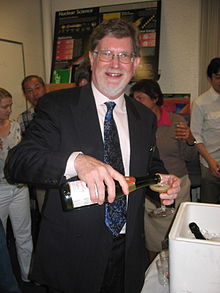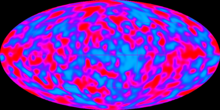George F. Smoot

George Fitzgerald Smoot III(lahir20 Februari1945) merupakan seorang ahliastrofizikdankosmologiAmerika Syarikat.
Beliau juga merupakan seorang professor fizik diUniversity of California, Berkeley.Beliau telah dianugerahkanHadiah Nobel dalam Fizik 2006,berkongsi denganJohn C. Matherkerana "penemuan mereka terhadap bentukjasad hitamdananisotrofilatarbelakang gelombang mikro kosmik".Penemuan ini menolong mengukuhkan teoribig-bangalam semesta menggunakan satelitCOBE(Cosmic Background Explorer). Merujuk kepada ahli jawatankuasa Hadiah Nobel, "projek COBE boleh dianggap sebagai titik permulaankosmologisebagai satu sains yang tepat ".[1]
Biografi[sunting|sunting sumber]
Pendidikan dan permulaan penyelidikan[sunting|sunting sumber]
Smoot telah lahir pada20 Februari1945diYukon,Florida.Beliau telah mempelajarimatematiksebelum bertukar keMassachusetts Institute of Technologydi mana beliau memperolehi duasarjana mudadalam matematik dan fizik dalam 1966, dan satu ijazahkedoktorandifizik zarahdalam tahun 1970.[2]Kemudian beliau telah bertukar ke bidang kosmologi, dan telah pergi keMakmal Kebangsaan Lawrence Berkeleydi mana beliau telah berkolaborasi denganLuis Walter Alvarezberkenaan dengan eksperimenHAPPE,satubelonstratosferabagi mengesanantijisimdalamatmosfera atas,di mana ia telah diramal olehkeadaan tetapmodel kosmologiyang kini samar-samar.
Kemudian beliau mengambil minat dalam latarbelakang gelombang mikro kosmik (CMB), sebelum ini ditemukan olehArno Allan PenziasdanRobert Woodrow Wilson.Satu persoalan yang belum diselesaikan pada masa itu adalah strukturalam semesta.Certain models predicted the universe to be inrotation,which left a trace in the CMB in the form oftemperaturedepending on the direction of observation. With the help of Alvarez andRichard A. Muller,he developed a differentialradiometerwhich measured the difference in temperature of the CMB between two directions 60degreesapart. The instrument, which was mounted on aLockheed U-2plane, made it possible to determine that the overall rotation of the universe was null (within the limit of accuracy of the instrument). It detected a variation in the temperature of the CMB corresponding to adipole,interpreted as theDoppler effectof the Earth's motion relative to the area of CMB emission, which is called thelast scattering surface.Such a doppler effect arises because theSun(and in fact theMilky Wayas a whole) is not stationary, but rather is moving at nearly 600km/swith respect to the last scattering surface. This is probably due to thegravitational attractionbetween our galaxy and a concentration of mass like theGreat Attractor.
Although Smoot attended MIT, he was not the sameSmootwho was laid end to end to measure theHarvard BridgebetweenCambridgeandBoston;this wasOliver R. Smoot.This confusion wasclarified by George Smoot himself.
Pengllibatan dalam COBE[sunting|sunting sumber]

At that time, the CMB appeared to be perfectly uniform excluding the distortion caused by the Doppler effect as mentioned above. This result contradicted with observations of the universe, with various structures (galaxies,galaxy clusters,etc.), indicating that the universe was relatively inhomogenouson a small scale. However, these structures formed slowly. Thus, if the universe is inhomogenous today, it would be inhomogenous at the time of the emission of the CMB as well, observable today through weak variations in the temperature of the CMB. It was the detection of these anisotropies that Smoot was working on in the late1970s.He then proposed toNASAa project involving asatelliteequipped with a detector that was similar to the one mounted on the U-2, but was more sensitive and not influenced byair pollution.The proposal was accepted and gave rise to the satelliteCOBE,and cost US$ 160 million. COBE was launched onNovember 18,1989,after a delay owing to the destruction of theSpace Shuttle Challenger.After more than two years of observation and analysis, the team of COBE, led by Smoot, announced on23 April1992to have detected negligible fluctuations in the CMB, a breakthrough in the scientific world.[3]
The success ofCOBEwas the outcome of prodigious team work involving more than 1,000 researchers, engineers and other participants. John Mather coordinated the entire process and also had primary responsibility for the experiment that revealed the blackbody form of the CMB measured by COBE. George Smoot had main responsibility for measuring the small variations in the temperature of the radiation[4].
Smoot collaborated withSan Francisco Chroniclejournalist Keay Davidson to write the general-audience bookWrinkles in Time[5],first published in 1994, that chronicled his team's efforts.
Projek masakini[sunting|sunting sumber]
After COBE, Smoot took part in another experiment involving a stratospheric balloon,MAXIMA,which was more precise than COBE, and refined the measurements of the anistrophies of the CMB. He is also a collaborator inSNAP,a satellite which is proposed to measured properties ofdark energy,and data from theSpitzer Space Telescopein connection withinfra-redradiation.
Rujukan luar[sunting|sunting sumber]
- Nobel Prize announcement
- Biographyat theLawrence Berkeley National Laboratory
- Berkeley lab articleDiarkibkan2006-11-18 diWayback Machine
Pautan luar[sunting|sunting sumber]
Rujukan[sunting|sunting sumber]
- ^"Information for the public"(PDF).The Royal Swedish Academy of Sciences.2006-10-03.Dicapai pada2006-10-05.
- ^"Nobelists' work supports big-bang theory"(Siaran akhbar).MITPress Office. 2006-10-03.Dicapai pada2006-10-03.
- ^Smoot, G. Fet al.,Structure in the COBE differential microwave radiometer first-year maps,Astrophysical Journal396,L1 (1992)
- ^Press release: Pictures of a newborn Universe
- ^Wrinkles in Timeby George Smoot and Keay Davidson, Harper Perennial, Reprint edition (October 1, 1994)ISBN0380720442

